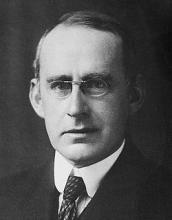Sir Arthur Stanley Eddington can be considered the father of theoretical astrophysics because of his work on stellar dynamics and composition and his exposition and application of Einstein’s relativity theories (announced in 1905 and 1915). His review in 1918 was the first English-language exposition of the subject and his book Mathematical Theory of Relativity (1923) was considered by Einstein himself to be the finest presentation in any language.
Born into an English Quaker family, Eddington was brought up by a mother widowed when he was barely two years old. His Quaker beliefs led him to embrace pacifism in protest of the First World War. These beliefs found expression in his popular books, among which are his Gifford Lectures of 1927.
Eddington started his tertiary education at Owens College Manchester and finished it at Trinity College Cambridge where when barely thirty-one he was elected Plumian Professor of Astronomy (succeeding Charles Darwin’s son George Darwin) and became the director of the university’s observatory the following year. Eddington famously organised two expeditions (to Brazil and West Africa, leading the latter himself) to observe the total solar eclipse of 19 May 1919. These expeditions measured precisely the gravitational bending of light from distant stars by the sun, which according to Einstein’s general relativity should be twice the amount predicted by Newton’s theory. The positive result announced by Eddington and others in the Royal Society under the gaze of Newton (his portrait was hanging in the meeting room) led in the words of an Einstein biographer to the latter’s instant ‘canonization’.
Eddington was intrigued by the philosophical implications of the then new physical theories of relativity and quantum mechanics and published a series of popular expositions of this subject: The Nature of the Physical World (1928 based on his 1927 Gifford Lectures), Science and the Unseen World (1929), New Pathways of Science (1935), and The Philosophy of Physical Science (1939). Philosophically an idealist, Eddington believed that the structure of relativity theory naturally couched in the language of ‘tensor calculus’ reflected the structure of human thought itself. He thought that quantum mechanics could also be brought within this framework and through the consequent unification of these two theories the values of all ‘universal constants’ should be calculable. In particular his infatuation with one of these numbers the ‘fine structure constant’ bordered onto numerical mysticism. Eddington first argued that its value should be exactly 1/136 but with improved measurements switched to trying to obtain the exact value of 1/137. At this point most researchers stopped taking any notice. (The current value is 1/137.03599976.)
One of the founders of quantum mechanics Erwin Schrödinger was much taken by Eddington’s ‘unified field theory’ program. Einstein also wrote four papers in 1923 in response. However no positive results emerged. Eddington’s program was published posthumously in monograph form as Fundamental Theory (1946) a book that is according to one biographer (A. V. Douglas) ‘incomprehensible to most readers and perplexing in many places to all but which represents a continuing challenge to some’.
Eddington’s belief that physical theory was strongly constrained by the structure of human mental processes led him to postulate a mental substratum to everything of which physical science had little to say. This substratum must be apprehended by other endeavours including religious faith. In the words of Schrödinger’s biographer Walter Moore ‘the later Eddington was a lonely and controversial genius who combined numerical legerdemain and idealist philosophy in a prose style of such eloquence that it charmed even those who could not follow his reasoning’.
Major biographies are A. V. Douglas, The Life of Arthur Stanley Eddington (1956) and C. W. Kilmister, Sir Arthur Eddington (1966).



